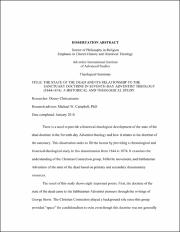| dc.description.abstract | There is a need to provide a historical-theological development of the state of the
dead doctrine in the Seventh-day Adventist theology and how it relates to the doctrine of
the sanctuary. This dissertation seeks to fill the lacuna by providing a chronological and
historical-theological study in this denomination from 1844 to 1874. It examines the
understanding of the Christian Connection group, Millerite movement, and Sabbatarian
Adventists of the state of the dead based on primary and secondary documentary
resources.
The result of this study shows eight important points. First, the doctrine of the
state of the dead came to the Sabbatarian Adventist pioneers through the writings of
George Storrs. The Christian Connection played a background role since this group
provided “space” for conditionalism to exist even though this doctrine was not generally
accepted among them. Second, the Sabbatarian Adventist pioneers unanimously believed
conditionalism after the Great Disappointment in October 1844 and practiced it through
their writings, especially when they expressed the hope of resurrection and immortality
for the loss of their loved ones. Third, there was an increase influence of the state of the
dead in the Seventh-day Adventist theology. It began as “truth” from 1840s to 1850s and
became an “important truth” from 1851 to 1853. It turned as a present truth in 1854 and
since 1872, the influence became greater since 9 of the 25 statements of belief related to
the state of the dead. The increasing amount of literature devoted to this topic during
1844 to 1874 indicated the growing influence of this doctrine in this church theology.
The fourth result is that there were two external factors that led to the significance
of the doctrine of the state of the dead in the Seventh-day Adventist theology. The rise of
modern spiritualism and the inquiries of the uniqueness of this denomination were
compared with other Adventists. Fifth, it showed the importance of Ellen White’s role in
showing the significance of this doctrine against spiritualism. Sixth, Seventh-day
Adventists evaluated Storrs’s idea and accepted only those that were in harmony with
their biblical concept.
The seventh finding is the relation of the state of the dead with the sanctuary
doctrine through the cleansing of the sanctuary, atonement for the blotting out of sin, and
pre-advent investigative judgment. They are related through the decision of the fate of
humanity. Eight, the Sabbatarian Adventist pioneers believed that the cleansing of the
sanctuary, atonement for the blotting out of sins, and pre-advent investigative judgment
were identical in work and time. Each are related to the state of the dead respectively as
well as collectively. | en_US |

